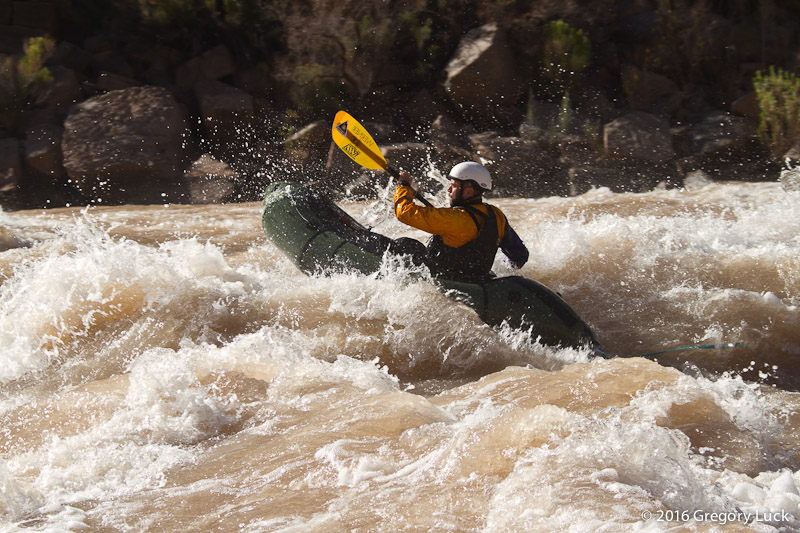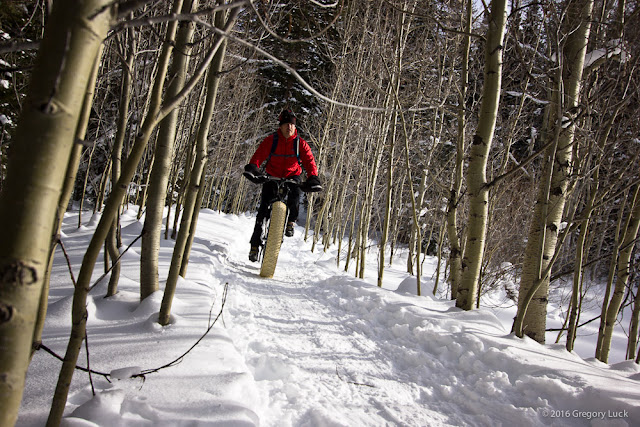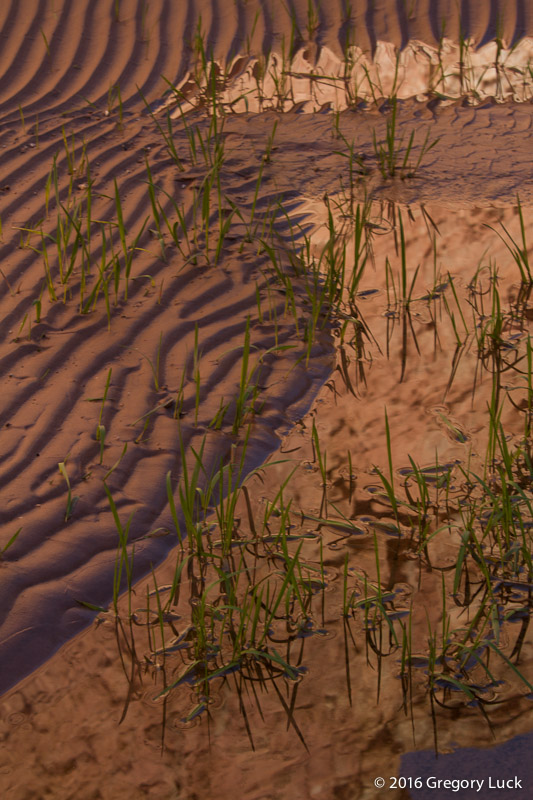 by Greg
by Greg
My apprehension began early. Months ahead of time. Somewhere between being invited on this Grand Canyon trip and deciding that I’d be a fool to turn down the invitation. But something inside me also wondered if I was a fool for accepting.
I’d describe my boating skills as “moderate”. I tend to shy away from the more adrenaline-soaked attractions of paddling—and any sport—while being drawn toward the out-there-somewhere feeling that boating—and bicycling, hiking, and, er, napping in the shade—allows; drawn to the more sedate attractions of scenery, geology, atmosphere and the small details of the lives and natural processes and the often subtle signs they leave behind. The chance to experience these was my primary motive for wanting to float the Grand. But the
blood sacrifice for floating the narrow corridor through the myriad layers of stone, past the secret corners of side canyons, beneath the ribbon of sky, amid the history and grandeur and frequently otherworldly beauty, was Big. Terrifying. Whitewater.
As the months passed, I tried to comfort and prepare myself, not so much by practicing my paddling, but by watching online videos of the Grand Canyon’s bigger rapids. This did not help. My adrenaline would spike. I would quaver. Then I would spend a long night being jarred awake by dreams of monster waves.
Sure, I was worried about being warm enough in January while floating in cold water and while sleeping on the river’s edge. And about having enough food stuffed into my boat and getting it stuffed into my mouth. And about keeping my camera gear dry. And about paddling all day when I hadn’t been paddling much. And about, what? Ringtail cats stealing my glasses? Lots of worries. But none of them could match my worry about massive raft-eating waves.
Not to philosophically excuse my Nervous Nelly tendencies, but… Worry is a tool that allows one to examine the potential future and to make preparations for it. I found this to be true for things like Cold and Food and Ringtail Cats. But when it came to whitewater, the more I thought about it, the more terrified I seemed to become. Right up until I almost missed the trip by somehow misplacing a day and having to dash to the put-in in the dark, arriving near-midnight, packing the last few bits in haste, and then not sleeping much.
The next morning we did our Park Ranger check-in, loaded the boats, strapped in and slipped into the cold, green water. I was wound pretty tight. Clenched. In fact, it might be fair to say that I barely had fun for the first three days. By the fourth day we’d been through lots of smaller rapids and a couple of the bigger rapids. And I began to realize that I probably wasn’t going to die. I’d been flipped over a few times. I’d rolled up a couple times. A couple more times I’d bailed out and had to swim. Do not misunderstand: the waves
actually were huge! And the rapids still scared me. But I began to see that they were mostly within my skill set. And that when I did swim, it wasn’t really so bad; just follow the protocol: hang on to the boat and paddle, wait for some calm, flip the boat over and get back in. Which is part of the charm of these little packrafts. They are easy to recover. They aren’t so heavy they take ropes and pulleys to re-flip, like a big raft. And they don’t take on much water when they’re vacated, like a kayak. I realized that I just had to stay out of the big holes, dodge the rocks, and have fun riding the waves. Fun!
By the end of the trip I had managed to paddle upright through almost all of the major rapids—by hook, crook, adrenaline, luck and maybe even some skill. I’d also gotten knocked over maybe half-a-dozen times, sometimes by surprisingly small rapids—suckerpunch! More importantly, I had re-found the fun. After running through the thrash and turmoil of waves and spray, past the squirrelly tail-water and into the calm beyond, I found my throat filled with hoots and giggles, laughing as each of us told the tales of our passage through the rapid.
And maybe there was even a glint in my eye, wondering what kind of challenge and fun the next rapid would bring.
With that, pictures and some explainin':
Before the confluence with the muddy Little Colorado River, the Colorado ran clear and green. Here, House Rock Rapid, Mike, Russell, Doom.



Mike and Jesse dive into Horn Rapid.

Mike, deep in Granite Rapid.
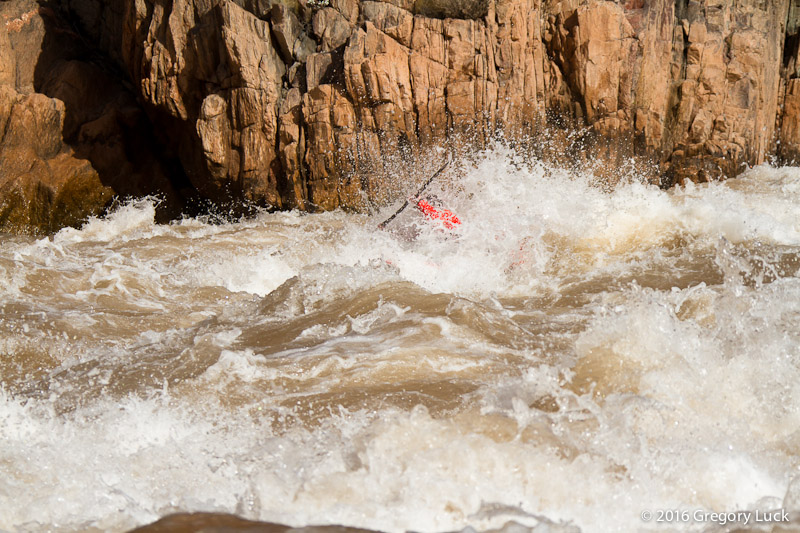
We read-and-ran Hermit. Intense 15-foot+ waves, but fairly friendly (in a thrashy, full-contact, terrifying way) and we all made it through upright. All of us but Jesse were having so much fun and giggling that we missed the river-left eddy. He caught it and carried his boat back up for another run.

Doom, Brian and Dave head into Serpentine Rapid where Dave takes a refreshing swim, gets back in, and carries on.



Webster leaves Tapeats Creek.

Mike and Jessie power through, but Upset Rapid lives up to its name for Dave, Webster, and, once I put my camera away, me.





Lava Falls Rapid is The Big One in the Grand Canyon. It had loomed large long before we made it there on Day 9. From our scout point, it was definitely the least organized, most unpredictable and toughest rapid to trace a line through. After some discussion, we agreed on what seemed to be the least horrible path.

Mike led in, with Jesse and Dexter behind.

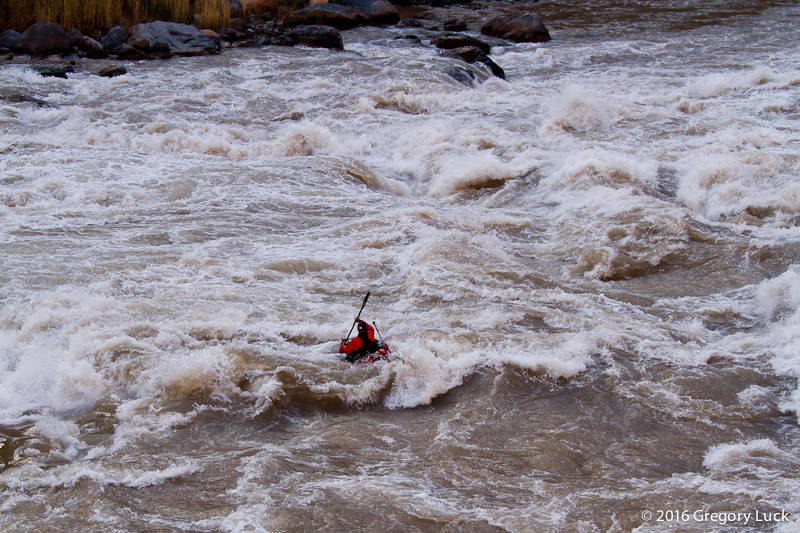
Mike got caught and surfed long enough that, for a moment, Jesse almost ran into him.


The first wave ate Webster's lunch and he "enjoyed" the rest of the rapid without his boat. My story: From the scout, the line just about almost made sense. But from the water, it was just a horizon line with huge sprays of water pounding upward from beyond. I was following Doom in, but when he swerved right, I stuck to my plan and followed the right-side riffles down the tongue and charged to the left, smashed through a "lateral wave" which was really just a roiling churn of thrash. Then crashed into a big wave on my right, managed a huge brace (thank you whitewater play park instincts, because I had no idea what I was doing) and surfed the wave for an hour (or part of a second) until it spit me into the "calmer" water beyond, where I was supposed to keep charging left to avoid the Big Kahuna, a massive recirculating wave to my right. My charge was insufficient and I washed right toward the gaping maw, diving downward into the trough, down toward the bottom of the river where I spun the boat to face the crest head-on as the wave lifted me upward, upward, reaching for the sky and paddling hard to--SMASH!--through the top of the wave, which, thankfully, paused its backward curl for a moment and allowed me through. I was whooping and hollering and giddy with the rush of it all and with my success, even as I fought through the thrashy tailwaters and into the eddy. Whew!
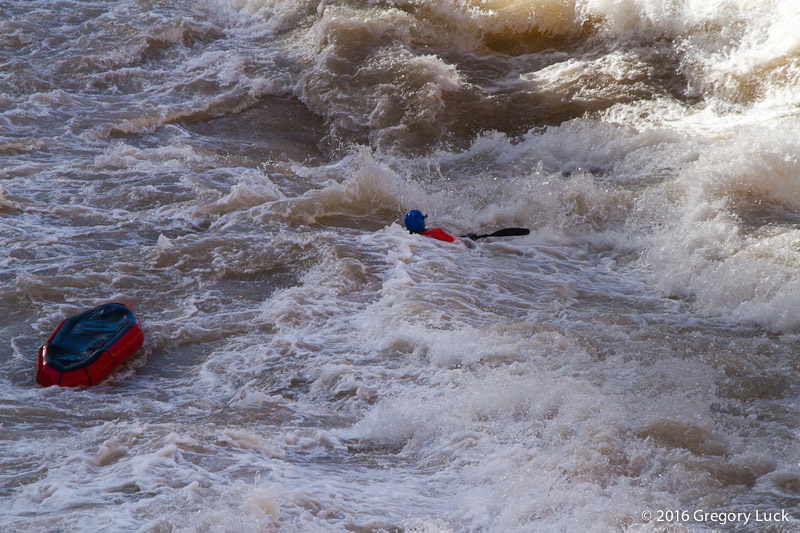
Laps: We made it to our camp early on day 10 and had time and sunshine available. Most of the guys dumped their gear and ran laps in 205-Mile Rapid. I sat in the warm sun and ate lunch and shot photos while they carried their empty boats back up and ran the rapid and over. Much fun was had. Technique was practiced. Lessons were learned. And I had fun trying to capture it as the afternoon wore on and the canyon shadow reached across the river. Then I grabbed my boat and ran up for a couple laps myself, grinning the whole time.





